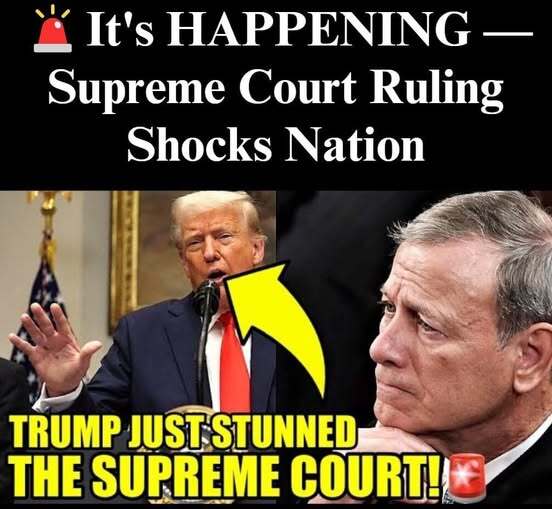Supreme Court’s 6–3 Ruling Limits Federal Judges’ Power to Block Policies Nationwide — A Major Win for Trump and a Shift in Judicial Authority That Could Redefine How Immigration, Climate, and Administrative Cases Are Handled Across the United States
The U.S. Supreme Court has issued a decision that is already being described as one of the most consequential rulings of the decade — and a major procedural victory for President Donald Trump. In a 6–3 decision announced late last month, the Court ruled that federal judges can no longer issue nationwide injunctions blocking government policies, a move that reshapes how lower courts interact with the executive branch.
The ruling stems from a case tied to the Trump administration’s attempt to challenge aspects of birthright citizenship, though the final judgment focuses not on immigration directly, but on the scope of judicial power. Writing for the conservative majority, Justice Amy Coney Barrett explained that district courts “lack the authority to impose relief beyond the plaintiffs before them,” arguing that sweeping injunctions have increasingly overstepped constitutional boundaries.
For decades, nationwide injunctions have been used by federal judges to temporarily halt controversial policies affecting millions — from immigration bans to environmental rollbacks. The Court’s decision effectively ends that practice, forcing future challenges to proceed case by case, rather than freezing entire federal programs across all 50 states.
Barrett wrote that this change was necessary to restore “balance between the judiciary and the executive,” asserting that unelected judges should not wield unilateral power to stop elected branches from executing federal law. “The Constitution does not authorize district courts to act as super-legislatures,” she said in the majority opinion.
In dissent, Justice Sonia Sotomayor, joined by Justices Elena Kagan and Ketanji Brown Jackson, warned that the ruling could make it harder for citizens to protect their rights. “When a government action threatens to harm millions, courts must have the power to prevent widespread injury,” she wrote. “This decision leaves many Americans without meaningful recourse.”
Political Reactions
President Trump celebrated the decision on Truth Social, calling it a “historic correction of judicial abuse.” He praised the Court for what he described as restoring “law and order” to the legal process, arguing that activist judges had been “blocking progress at every turn” during his first term.
Republicans largely echoed his sentiment, framing the decision as a win for executive authority. Senate Majority Leader Mike Johnson said, “This ruling finally puts an end to rogue judges who halted policies meant to protect Americans and secure our borders.”
Democrats, however, expressed alarm. Senator Elizabeth Warren warned that the decision “hands far too much unchecked power to the White House,” potentially allowing administrations to enforce sweeping policies without immediate judicial restraint. Civil rights groups and environmental advocates also voiced concern, noting that nationwide injunctions had been crucial in halting policies such as the “Muslim travel ban” and environmental deregulations.
Broader Implications
Legal analysts say the ruling could have far-reaching effects across multiple policy areas, including immigration, environmental protection, health care, and federal agency regulation. Without the ability to issue nationwide injunctions, lawsuits against federal policies may now proceed through a patchwork of regional cases, leading to conflicting rulings until the Supreme Court itself intervenes.
“This decision will slow the ability of courts to respond to national controversies,” said Professor Amelia Chen, a constitutional law expert at Georgetown University. “But it also reduces forum-shopping — where litigants pick specific courts known for blocking policies they oppose.”
For the Trump administration, the ruling provides a smoother path to implementing policy changes without immediate nationwide obstruction. Future administrations, regardless of party, will also benefit from a clearer separation of powers, though critics argue it could come at the expense of swift judicial relief for affected citizens.
Looking Ahead
The Supreme Court’s decision reflects the conservative majority’s ongoing effort to limit the power of federal courts and redefine the relationship between branches of government. With Trump continuing to nominate judges aligned with his legal philosophy, this ruling marks yet another step in reshaping the federal judiciary’s long-term influence.
Whether seen as a victory for constitutional restraint or a blow to accountability, the ruling underscores a new era in American governance — one where national policy battles may take longer to resolve, and where the balance between liberty and authority is once again up for debate.


